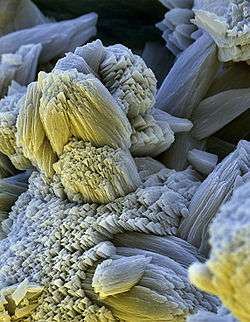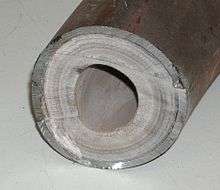Limescale

Limescale is the hard, off-white, chalky deposit found in kettles, hot-water boilers and the inside of inadequately maintained hot-water central heating systems.
It is also often found as a similar deposit on the inner surface of old pipes and other surfaces where "hard water" has evaporated. In addition to being unsightly and hard to clean, limescale seriously impairs the operation or damages various components.[1]
The type found deposited on the heating elements of water heaters has a main component of calcium carbonate. Hard water contains calcium (and often magnesium) bicarbonate or similar ions. Calcium salts, such as calcium bicarbonate and calcium carbonate are both more soluble in hot water than cold water. Thus, heating water does not cause calcium carbonate to precipitate per se. However, there is an equilibrium between dissolved calcium bicarbonate and dissolved calcium carbonate:
Ca2+ + 2HCO3− ⇋ Ca2+ + CO32− + CO2 + H2O
where the equilibrium is driven by the carbonate/bicarbonate, not the calcium. Note that the CO2 is dissolved in the water.
There is also an equilibrium of carbon dioxide between dissolved in water (dis) and the gaseous state (g): CO2(dis) ⇋ CO2(g)
The equilibrium of CO2 also moves to the right towards gaseous CO2 when the water temperature rises. When water that contains dissolved calcium carbonate is warmed, CO2 is removed from the water as gas causing the equilibrium of bicarbonate and carbonate to shift to the right, increasing the concentration of dissolved carbonate. As the concentration of carbonate increases, calcium carbonate precipitates as the salt: Ca2+ + CO32− ⇋ CaCO3.
As new cold water with dissolved calcium carbonate/bicarbonate is added and heated, CO2 gas is removed, carbonate concentration increases, and more calcium carbonate precipitates.
Descaling agents are used to remove scale. Prevention of scale build-up relies on the technologies of water softening.

Related materials
Soap scum
Calcium cations from hard water can also combine with soap, which would dissolve in soft water. This combination often forms soap scum which precipitates out in a thin film on the interior surfaces of baths, sinks, and drainage pipes.
Iron components of scale
Scale is often coloured because of the presence of iron-containing compounds. The three main iron compounds are wustite (FeO), hematite (Fe2O3), and magnetite (Fe3O4).
See also
References
- ↑ Hermann Weingärtner, "Water" in Ullmann's Encyclopedia of Industrial Chemistry, December 2006, Wiley–VCH, Weinheim. doi:10.1002/14356007.a28_001